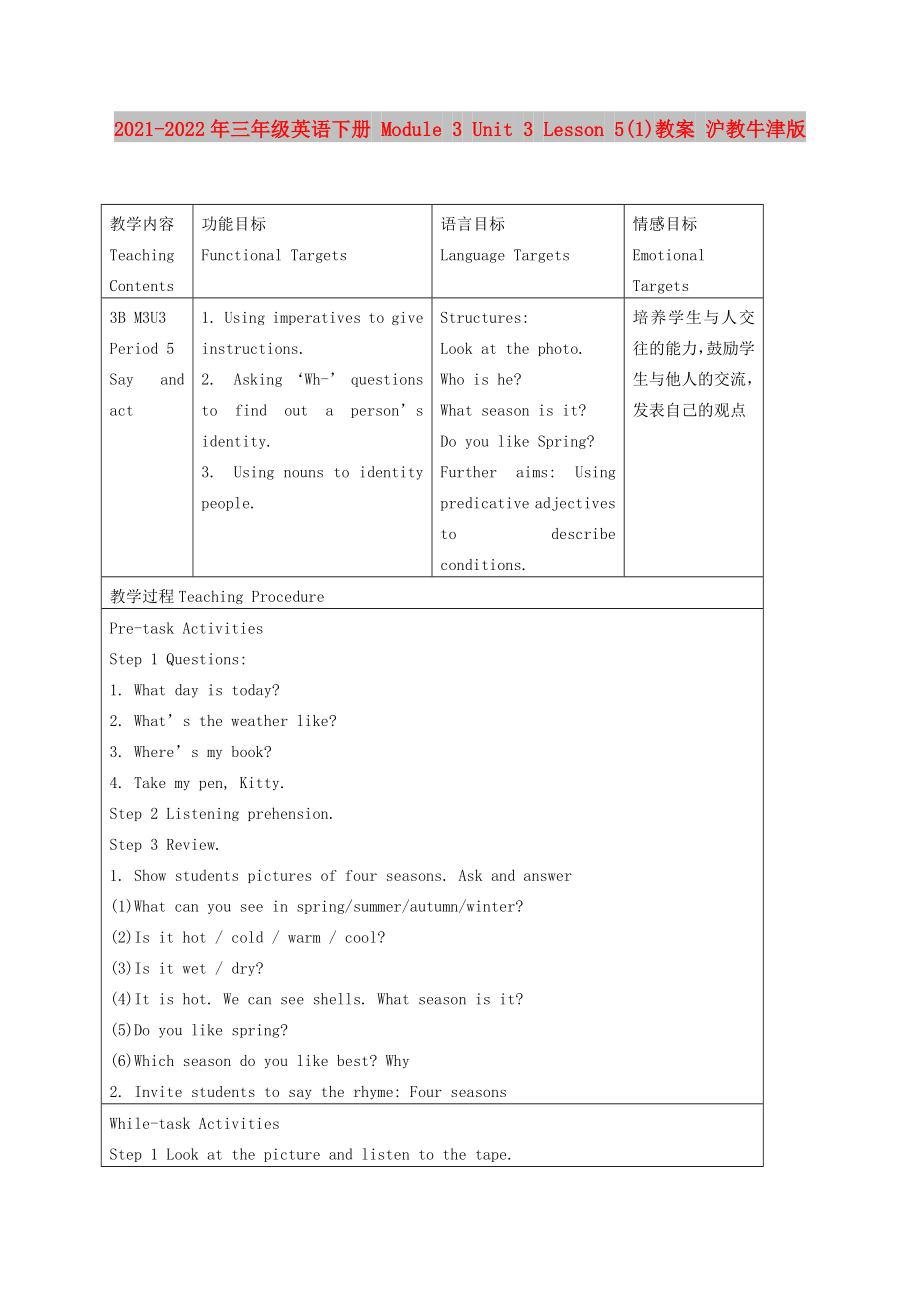《2021-2022年三年級英語下冊 Module 3 Unit 3 Lesson 5(1)教案 滬教牛津版》由會員分享�����,可在線閱讀����,更多相關(guān)《2021-2022年三年級英語下冊 Module 3 Unit 3 Lesson 5(1)教案 滬教牛津版(4頁珍藏版)》請?jiān)谘b配圖網(wǎng)上搜索�����。
1��、2021-2022年三年級英語下冊 Module 3 Unit 3 Lesson 5(1)教案 滬教牛津版
教學(xué)內(nèi)容
Teaching Contents
功能目標(biāo)
Functional Targets
語言目標(biāo)
Language Targets
情感目標(biāo)
Emotional Targets
3B M3U3
Period 5
Say and act
1. Using imperatives to give instructions.
2. Asking ‘Wh-’ questions to find out a person’s identity
2�、.
3. Using nouns to identity people.
Structures:
Look at the photo.
Who is he?
What season is it?
Do you like Spring?
Further aims: Using predicative adjectives to describe conditions.
培養(yǎng)學(xué)生與人交往的能力�,鼓勵學(xué)生與他人的交流,發(fā)表自己的觀點(diǎn)
教學(xué)過程Teaching Procedure
Pre-task Activities
Step 1 Questions:
1. What d
3����、ay is today?
2. What’s the weather like?
3. Where’s my book?
4. Take my pen, Kitty.
4、
Step 2 Listening prehension.
Step 3 Review.
1. Show students pictures of four seasons. Ask and answer
(1)What can you see in spring/summer/autumn/winter?
(2)Is it hot / cold /
5�、warm / cool?
(3)Is it wet / dry?
(4)It is hot. We can see shells. What season is it?
(5)Do you like spring?
(6)Which season do you like best? Why
2. Invite students to say the rhyme: Four seasons
While-task Activities
Step 1 Look at
6、 the picture and listen to the tape.
Step 2 Talk about the season. Ask: Do you like … (season)?
Play the dialogue on the cassette while students follow in their books. Students content through listening.
Play the dialogue in
7����、 four parts. Students follow the tape and repeat.
Encourage students to say: In spring / summer / autumn / winter, it’s…/ We can see…
Step 3 Show a photograph and say: Look at the photo
8、graph. To elicit: Who is he/she. Then answer: He’s my…/She’s my
Take out student’s photograph and introduce the person in the photograph.
Students work in pairs. Ask and answer. …
Step 4 Divide students in pairs. Ask them to act out the dialogue.
Post-task Activities
Step 1 Listen to the tape a
9��、nd read dialogue.
Step 2 According to the dialogue make new ones. eg: S1: Look at this photograph. Who is she?
S2: She’s my big sister, Rose.
S1: What season is it?
S2: It is summer. It’s hot. The sun is shining. Rose has
10�����、her blue sunglasses.
S2: She has a nice dress. It is pink.
S1: I like summer. It’s hot. I like swimming. I like ice-creams. Do you like summer?
S2: No, I don’t like it. I like autumn. I like kites. It is not hot. It is cool.
S1: But in autumn it is dry. The leaves fall. S2: Yes, it is
11��、.
Step 3 Students write the correct words in the blanks provided.
Step 4 Students exchange their work and check answers.
板書設(shè)計(jì)Blackboard Writing
Look at this photo.
W
12、ho is he?
What season is it?
Do you like spring?
課后作業(yè) Assignments
課后反思 Reconsideration
1. Listen to the tape and read the dialogue.
2. Act out the dialogue.
附送:
2021-2022年三年級英語下冊 Module 3 Unit 3(1)教學(xué)反思 滬教牛津版
本節(jié)課主要目標(biāo)是讓學(xué)生能聽說讀寫單詞 weather, spring, summer, autumn, winter, h
13���、ot, cold , 熟練運(yùn)用句型What’s the weather like…�?聽懂會說�,會讀,會寫句子:Which season do you like best? I like …best. Why? Because it’s ….I can … in ….
在這節(jié)課中要求學(xué)生掌握有關(guān)四季的單詞和描述四季的詞語及其用于描述天氣的句型及其一些與之相應(yīng)的活動情況的句型:What’s the weather like……�?What do you usually do? Which season do you like best?
根據(jù)本課教學(xué)內(nèi)容,我首先通過free talk,引
14�、出一年有四個季節(jié),自然導(dǎo)入新課The Seasons�����,然后用Which is the first season of a year? Which season es after spring?等句型引出? spring, summer, autumn, winter四個季節(jié)�,接著用 Look and guess的游戲鞏固四個季節(jié)����,同時也用游戲來激發(fā)學(xué)生的興趣。然后利用詢問季節(jié)天氣引出句型What’s the weather like today?及其sunny, cloudy, rainy等單詞的教授��,并通過To be a?weather reporter的游戲���,復(fù)習(xí)了剛才所學(xué)的單詞���。然后利用
15����、My favourite season is spring, I like spring best.引出句型Which season do you like best? 的教學(xué)�。
最后我以Fill in a form來調(diào)查學(xué)生的喜好,并綜合了所學(xué)句型Which season do you like best? What’s the weather like……��?What do you usually do? 采取“任務(wù)型”的教學(xué)手段��,安排學(xué)生以小組為單位開展討論�����,通過讓學(xué)生小組調(diào)查�����,讓學(xué)生在活動中學(xué)習(xí)�����,既能使學(xué)生復(fù)習(xí)新知�,又使學(xué)生感受到完成任務(wù)后的喜悅。也能將課堂氣氛推向了高潮。
16�����、歸納總結(jié)是本課的最后一個環(huán)節(jié)�����。在這個環(huán)節(jié)中���,我把本課的主要語言知識又再次呈現(xiàn)在學(xué)生面前���,給學(xué)生做了一個簡明扼要的歸納,并用一個Chant使學(xué)生進(jìn)一步地了解了本課所學(xué)�,加強(qiáng)學(xué)生的記憶。
在本課教學(xué)中我始終遵循“多信息�、高密度、快節(jié)奏���、勤反復(fù)”的原則展開教學(xué),并且在教學(xué)中注意教學(xué)的層次性�。同時針對本課的教學(xué)重點(diǎn)與難點(diǎn),在教學(xué)中采用“看看����、說說����、唱唱”等多種活動形式����,結(jié)合現(xiàn)實(shí)生活,讓學(xué)生在活動中學(xué)習(xí)��,引導(dǎo)學(xué)生主動參與��、主動探索�、主動思考、主動實(shí)踐����,以實(shí)現(xiàn)學(xué)生語言智能、交往智能等多方面能力的綜合發(fā)展��,充分調(diào)動其學(xué)習(xí)的積極性��、主動性和創(chuàng)造性�����。
回過頭來再看這節(jié)課,存在好多遺憾���。首先由于本課所教的單詞較多��,過多機(jī)械性的朗讀使學(xué)生很多時候積極性不高����。其次因?yàn)闀r間來不及��,課中的小組調(diào)查和歸納總結(jié)中的Chant未能在課上完成�����。另外有些細(xì)節(jié)部分沒有處理好��,學(xué)生的積極性還需要更積極地調(diào)動起來��,在整個教學(xué)過程中顯得過于的緊張��,使整個教學(xué)過程沒有達(dá)到預(yù)期的效果���。
在本次教學(xué)中��,我深深體會到教師需要改變教學(xué)觀念,教學(xué)需要藝術(shù),需要機(jī)智�����,需要創(chuàng)新��,基于教材又不拘泥于教材�,只有這樣,才能適應(yīng)課改大潮�。
 2021-2022年三年級英語下冊 Module 3 Unit 3 Lesson 5(1)教案 滬教牛津版
2021-2022年三年級英語下冊 Module 3 Unit 3 Lesson 5(1)教案 滬教牛津版

